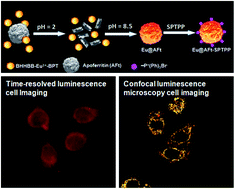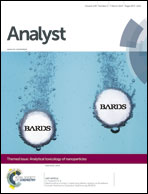Preparation and functionalization of a visible-light-excited europium complex-modified luminescent protein for cell imaging applications
Abstract
Lanthanide complex-based luminescent bioprobes have shown great utility in a variety of time-resolved luminescence bioassays, but these bioprobes often require UV excitation and suffer from problems related to bioaffinity and biocompatibility for in vivo applications. In this work, a new visible-light-excited europium(III) complex with the maximum excitation wavelength over 400 nm, BHHBB–Eu3+–BPT {BHHBB: 1,2-bis[4′-(1′′,1′′,1′′,2′′,2′′,3′′,3′′-heptafluoro-4′′,6′′-hexanedion-6′′-yl)-benzyl]-benzene; BPT: 2-(N,N-diethylanilin-4-yl)-4,6-bis(pyrazol-1-yl)-1,3,5-triazine}, has been synthesized for the preparation of an artificial luminescent protein that can be used as a visible-light-excited luminescent bioprobe for cell imaging. By encapsulating BHHBB–Eu3+–BPT into apoferritin with a simple dissociation–reassembly method, the luminescent protein, Eu@AFt, with a maximum excitation peak at 420 nm and a long luminescence lifetime of 365 μs was fabricated and successfully used for visible-light-excited time-resolved luminescence cell imaging. Moreover, by conjugating a mitochondria-targeting molecule, (5-N-succinimidoxy-5-oxopentyl)-triphenylphosphonium bromide (SPTPP), onto the surface of Eu@AFt, a mitochondria-specifically-tracking luminescent probe, Eu@AFt–SPTPP, was further prepared and used for visible-light-excited confocal luminescence microscopy imaging to visualize the mitochondria of living cells.


 Please wait while we load your content...
Please wait while we load your content...